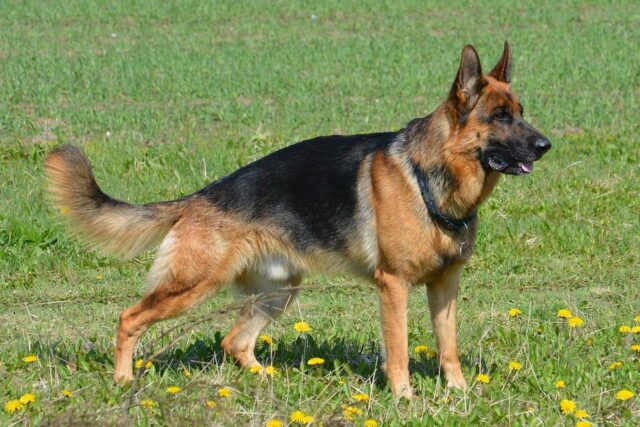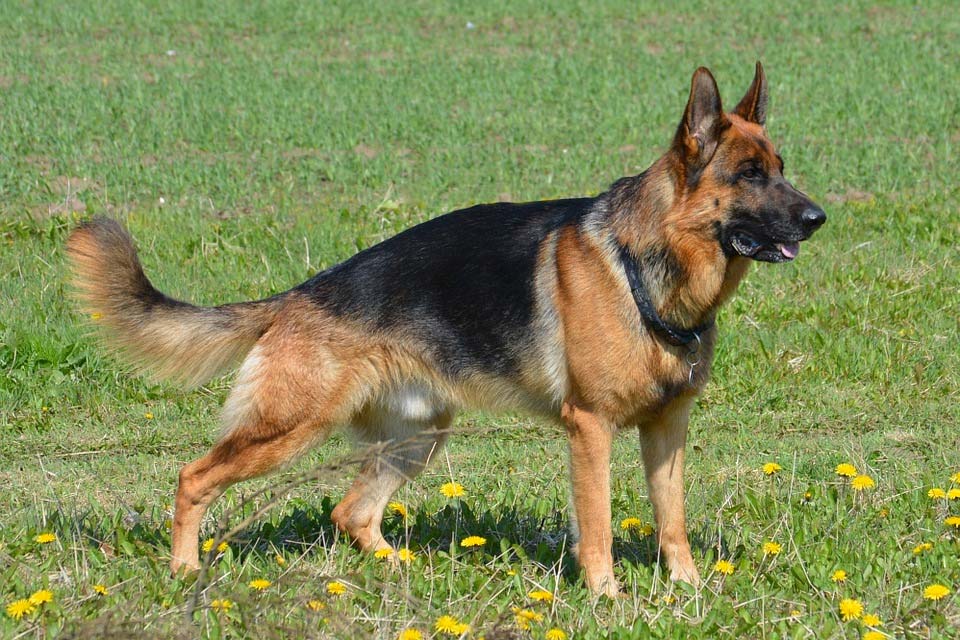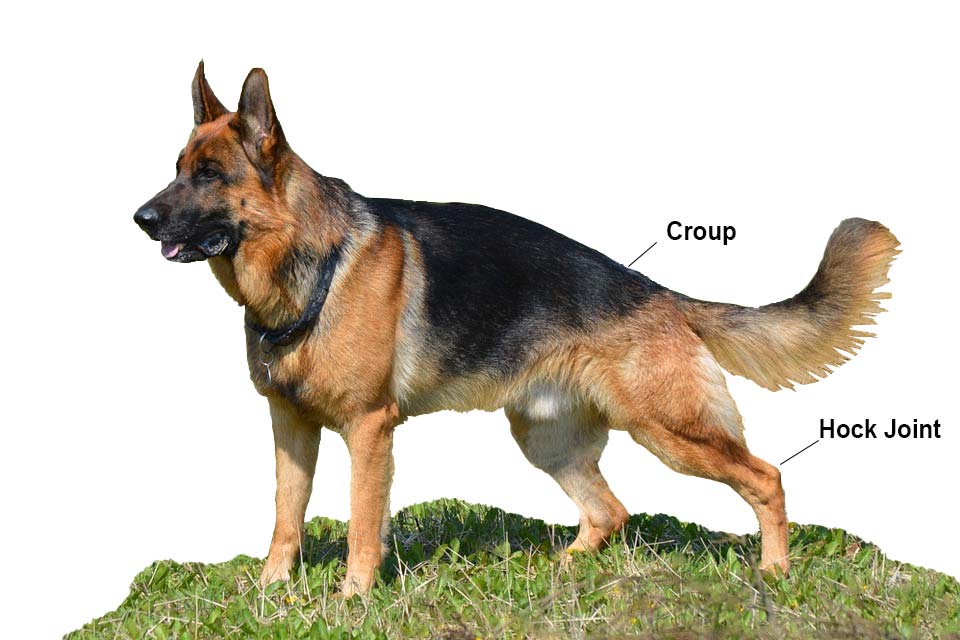
In short German Shepherd tails can have a slight curve to them or even a distinctive looped curl. Even dogs with a straight tail can still hold its tail with a slight curve now and then.
Even though a curled tail can be normal for Shepherds, the AKC has strict standards on what it considers a “perfect” tail for show purposes or as desired breeding traits.

Table of Contents
Why Does My German Shepherd’s Tail Curl?
Are German Shepherds’ Tails Supposed To Curl?
German Shepherds are proud, easily trainable, highly intelligent dogs, who love being active and pleasing their owners. It doesn’t matter to them if their tail curls or remains straight at attention in it’s typical bushy saber-like pose.
But sometimes if our dog doesn’t match-up to the typical image of the German Shepherd we can begin to question if our GSD is “normal”.
If you are interested in showing your Shepherd or wonder if you indeed have a pure-bred dog we will help you determine if your Shepherd meets the standard or AKC definition of German Shepherd dogs.
If you are wondering why your German Shepherd tail looks different than most Shepherd tails because you wonder if it is damaged or injured we’ll cover that as well.
German Shepherd AKC Tail Standards
Let’s get right to it and go over the American Kennel Club standards for the German Shepherd tail.
Here is what the AKC says in regard to German Shepherd tail positions:
“Tail bushy, with the last vertebra extended at least to the hock joint. It is set smoothly into the croup and low rather than high. At rest, the tail hangs in a slight curve like a saber. A slight hook- sometimes carried to one side-is faulty only to the extent that it mars general appearance. When the dog is excited or in motion, the curve is accentuated and the tail raised, but it should never be curled forward beyond a vertical line. Tails too short, or with clumpy ends due to ankylosis, are serious faults. A dog with a docked tail must be disqualified.” [source]

Now let’s decode what they are saying there just in case you don’t speak show dog standards.
What is a canine hock joint?
The canine hock joint is like the ankle joint in humans. The hock is located on a dog’s back leg below the knee. The hock creates that sharp angle at the back of the dog’s rear legs.
Therefore when AKC says the last vertebrae in the tail must extend past the hock joint it simply means at rest the tail should hang low past the dog’s “knee”.
What is a canine croup?
The croup is the section of the dog where the back flows into the tail. Therefore according to AKC standards the back should flow into the croup which smoothy transitions into the tail. The position of the tail should hang down rather than be set high up on the croup.
When a German Shepherd is in motion the tail tends to raise up and curl slightly however the curl should not be so pronounced that is curls past a vertical line and doubles back onto the dog’s back.
What is a docked tail?
A docked tail is purposely cropped or surgically removed (called a caudectomy) to change the appearance usually for cosmetic reasons.
According to AKC standards a German Shepherd with a docked tail is cause for disqualification in competitions.
What is ankylosis?
Ankylosis, is the complete loss of movement in a joint caused by degeneration and fusion of the bony surfaces. This may result from injury, infection, or inflammation. Ankylosis in dogs may also occur as a consequence of surgical fusion of a diseased joint to correct a deformity or to alleviate persistent pain. [source] A shortened tail do to Ankylosis is a serious fault according to AKC standards.
Why Does My German Shepherd’s Tail Curl?
You may be wondering if a curly tail in German Shepherds is normal? A typical German Shepherd tail is supposed to be between 9 and 14 inches long. Basically long enough to reach past the hock joint.
Curly tails in Shepherds are a genetic trait. So your dog’s tail might just curl normally by nature. It could also be a sign of mixed breeding. While a curly tail doesn’t always indicate cross-breeding, that might be the case.
A Shepherd’s tail could also have a curl caused by tail breakage at birth or due to problems in the womb. If your dog does have a prominent curly tail and you are certain she is a pure-bred Shepherd it could just come down to random genetics. That is why a purebred German Shepherd can still have a curly tail.
So it is perfectly normal for your German Shepherd to have a curly tail, because the curl is a genetic trait passed down from one or both parents, and not necessarily the fault of the breeders.
A curly tail is only a problem if you intend to show your dog as the AKC has strict standards when it comes to the shape and curl of the tail.
Are Curly Tails More Prone To Tail Problems?
In and of itself a curly tail is unlikely to have an impact on the incidence of tail problems or be an indicator that your dog will develop them down the road.
The rate of tail problems and other genetic issues are most impacted by breeding. That’s why it is important to carefully vet the breeders you purchase your shepherd from.
That being said many future Shepherd owners ask if it’s possible to avoid breeding puppies with curly tails. Unfortunately it isn’t always obvious unless one of the parents already has a defective tail since the genetic markers for a tail curl can be recessive.
Common Tail Problems In German Shepherds
Even though a curled tail is not an indication of future problems with the tail German Shepherds do have three common issues with their tail.
Skin infections
German Shepherd tails usually do not have that much skin, so this area is prone to infection. That’s also why it can be difficult to treat skin diseases on the tail.
Infections can lead to hair loss due to constant itching and chewing to relieve the discomfort of allergies. That is also perhaps the main reason your Shepherd might be biting his tail. Cuts, scrapes, and bites can also lead to skin infection. If left untreated hair loss is likely.
Since dogs are likely to lick or scratch infected areas topical antibiotics are usually not very effective. For that reason oral antibiotics are usually recommended.
Anal Furunculosis
An inefficient immune response or genetic traits passed down from the parents can cause a chronic inflammatory disease called Anal Furunculosis.
It’s a skin disease which usually presents under German Shepherd tails and around the anus as inflammation (swelling) and ulceration (open wounds).
It typically occurs in middle age to older German Shepherds. And Shepherds make up over 80% of all cases. [source]
Anal furunculosis thrives in areas with a lack of good airflow and wet or damp ares such as under a thick bushy tail in a Shepherd with a standard relaxed tail position.
In that regard a Shepherd with a curly tail is less likely to develop this issue because the tail curls higher away from the anus creating better air flow.
Limber Tail Syndrome
Limber Tail, also known as, Acute Caudal Myopathy, cold-water tail, broken wag, swimmer’s tail, frozen tail, and sprung tail is usually due to muscle strain or sprain in a dog’s tail.
Often caused by overexertion, it can also be caused by:
- Swimming in cold water
- Cold weather
- Climate changes
- Too much confinement in a crate
- Excessive exercise
The tail muscles can become swollen and painful, and the tail may become completely limp. Your Shepherd may try to lick or chew his tail, avoid wagging his tail, or be in noticeable discomfort if you try to move the tail.
Some of the symptoms of Limber Tail Syndrome mimic those of more serious issues and injury so it is always a good idea to have a vet take a look to rule out other problems.
The good news is that limber tail syndrome is best treated by rest and giving your dog time to recover on his own. Using a warm compress can reduce swelling and pain, but some veterinarians may prescribe muscle relaxers or anti-inflammatories if needed.
Up Next: Read about Dwarf German Shepherds, a rare genetic disorder in which they stay the size of a puppy.








